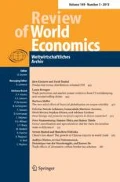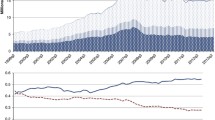Abstract
This paper studies the bilateral determinants of the international asset positions of banks, and subsequent bilateral adjustment during the global financial crisis and ensuing recovery phase. We find empirical support for traditional gravity-type variables. Exploiting a comprehensive dataset of bilateral bank assets, combined with a cross-country database on capital controls and macroeconomic policies, empirical evidence is provided for the effects of macroeconomic tools on the portfolio reallocation of internationally active banks. Specifically, higher current account balances in recipient countries are associated with higher inflows in debt assets, while restrictions on asset inflows and higher central bank reserves are related to lower cross-border flows of bank investment during the crisis and post-crisis periods, with heterogeneous effects across asset type. Finally, stronger institutions in recipient countries are positively associated with the international investment of banks, with inflows to debt assets being the most sensitive asset category across the financial cycle.





Similar content being viewed by others
Notes
As highlighted by Galstyan and Lane (2013), these source/destination country fixed effects filter common trends and valuation effects out of portfolio allocation, so that what remains is the purely bilateral variation.
Observe that \(\beta _{j}\) also controls for asset price movements, since shifts in the dollar prices of assets in country j are common to all investors (Galstyan and Lane 2013).
By the application of the Frisch-Waugh-Lovell theorem, the partial coefficient can be estimated by regressing the residual vector \({\hat{\varepsilon }}_{ij}\) from \(\Delta \ln (A_{ij,07-09})=\beta _{i}+\beta _{j}+ {\textit{\textbf{g}}}_{ij,07}\varvec{\eta }+\varepsilon _{ij}\) specification on the residual vector \({\hat{\epsilon }}_{ij}\) from Eq. (1) (Davidson and MacKinnon 2004).
The logic is similar to that of footnote 5.
While the original SUR method assumes a balanced panel, we have opted to use an unbalanced panel in order to maximize information by employing more observations. It is important to mention that in the case of unbalanced panel the SUR method cannot be proven to deliver a positive definite residual covariance matrix. We thank Christopher Baum for pointing this out and sharing his STATA code.
We opt for pairwise correlations instead of bi-variate regressions as we find scatterplots more informative and visually appealing. We do, however, report statistical significance of correlations.
The IMF commenced regular production of the CPIS in 2001, however, a once off limited version of the CPIS is also available for year 1997.
For a detailed discussion of the newly available sectoral breakdowns of reporting countries bilateral asset holdings see Galstyan et al. (2016).
The CPIS forms the primary dataset for our analysis. All other datasets used in gravity-type regressions are matched against the bilateral identifiers of the CPIS. This also implies that for the correlation analysis, the CPIS partners constitute the primary identifiers against which the other datasets are merged.
The number of countries varies by asset class. See the Appendix for a detailed list of countries.
The significance of imports also highlights the general importance of bilateral linkages.
See footnotes 5 and 6.
For this purpose, we use only statistically significant fixed effects. Across all specification, the average of the fraction of statistically significant fixed effects to the total estimated number of fixed effects is 72%, the minimum and the maximum stand at 15 and 100%, while the median stands at 78%. In only one specification the fraction of statistically significant effects to the total number of estimated effects is below 60%.
To re-iterate, our preference for this approach is broadly based on Pesaran and Smith (2014), who study the problem of interpreting the signs of estimated coefficients in multivariate time-series regressions and show that the sign of the total impact (both direct and indirect) can be obtained by using a bi-variate regression. Furthermore, we opt for pairwise correlations instead of bi-variate regressions as we find scatterplots more informative and visually appealing.
For simplicity, we will refer to the extracted fixed-country characteristics as FE-asset.
Due to the unbalanced nature of the extracted fixed effects we choose to use bivariate correlations instead of multivariate correlations with a smaller set of overlapping observations.
These variables capture the state of policy at the beginning of period under consideration.
Sectoral detail in the Coordinated Direct Investment Survey of the IMF would provide for complete bilateral positions of banks.
References
Alfaro, L., & Kanczuk, F. (2019). “Undisclosed Debt Sustainability,” NBER Working Papers 26347, National Bureau of Economic Research.
Aviat, A., & Coeurdacier, N. (2007). The geography of trade in goods and asset holdings. Journal of International Economics, 71, 22–51.
Bénétrix, A., McCauley, R., McGuire, P., & von Peter, G. (2019). Financial deglobalisation in banking? Journal of International Money and Finance, 94, 116–131.
Bruno, V., & Shin, H. S. (2015). Capital flows and the risk-taking channel of monetary policy. Journal of Monetary Economics, 71, 119–132.
Buch, C. (2005). Distance and international banking. Review of International Economics, 13, 787–804.
Buch, C. M., Neugebauer, K., & Schroder, C. (2013). “Changing forces of gravity: How the crisis affected international banking,” Discussion Papers 48/2013, Deutsche Bundesbank, Research Centre.
Bussière, M., Schmidt, J., & Valla, N. (2016). “International financial flows in the new normal: Key patterns (and why we should care)”, CEPII Policy Brief 2016-10, CEPII research center.
Davidson, R., & MacKinnon, J. (2004). Econometric theory and methods. Oxford: Oxford University Press.
Daude, C., & Fratzscher, M. (2008). The pecking order of cross-border investment. Journal of International Economics, 74, 94–119.
Emter, L., Schmitz, M., & Tirpák, M. (2018). “Cross-border banking in the EU since the crisis: What drives the great retrenchment?” European central bank working paper series No. 2130.
Fernández, A., Klein, M., Rebucci, A., Schindler, M., & Uribe, M. (2015). “Capital control measures: A new dataset,” NBER working papers 20970, National Bureau of Economic Research.
Forbes, K., Fratzscher, M., & Straub, R. (2015). Capital-flow management measures: What are they good for? Journal of International Economics, 96, S76–S97.
Forbes, K., Fratzscher, M., Kostka, T., & Straub, R. (2016). Bubble thy neighbour: Portfolio effects and externalities from capital controls. Journal of International Economics, 99, 85–104.
Forbes, K., & Warnock, F. (2012). Capital flow waves: Surges, stops, flight, and retrenchment. Journal of International Economics, 88, 235–251.
Galstyan, V. (2019). Estimates of foreign assets and liabilities for Ireland. Journal of the Statistical and Social Inquiry Society of Ireland, 48, 142–162.
Galstyan, V., & Lane, P. (2013). Bilateral portfolio dynamics during the global financial crisis. European Economic Review, 57, 63–74.
Galstyan, V., Lane, P., Mehigan, C., & Mercado, R. (2016). The holders and issuers of international portfolio securities. Journal of the Japanese and International Economies, 42, 100–108.
Ghosh, A. R., Ostry, J. D., & Tsangarides, C. G. (2012). Shifting motives: explaining the buildup in official reserves in emerging markets since the 1980's. IMF Working Paper No12/34.
International Monetary Fund. (2002). Coordinated portfolio investment survey guide (2nd ed.). Washington: International Monetary Fund.
International Monetary Fund. (2011). Balance of payments and international investment position manual (BPM6) (6th ed.). Washington: International Monetary Fund.
Kose, A., Prasad, E., Rogoff, K., & Wei, S.-J. (2009). Financial globalization: A reappraisal. IMF Staff Papers, Palgrave Macmillan, 56, 8–62.
Lane, P. (2006). Global bond portfolios and EMU. International Journal of Central Banking, 2, 1–23.
Lane, P., & Milesi-Ferretti, G. M. (2008). International investment patterns. Review of Economics and Statistics, 90, 538–549.
Lane, P., & Milesi-Ferretti, G. M. (2011). Cross-border investment in small international financial centres. International Finance, 14, 301–330.
Lane, P., & Milesi-Ferretti, G. M. (2012). External adjustment and the global crisis. Journal of International Economics, 88, 252–265.
Lane, P., & Milesi-Ferretti, G. M. (2017). “International financial integration in the aftermath of the global financial crisis,” IMF working paper WP/17/115, International Monetary Fund.
Magud, N., Reinhart, C., & Rogoff, K. (2011). “Capital controls: Myth and reality—A portfolio balance approach,” NBER working papers 16805, National Bureau of Economic Research.
Martin, P., & Rey, H. (2004). Financial super-markets: Size matters for asset trade. Journal of International Economics, 64, 335–361.
Milesi-Ferretti, G. M., & Tille, C. (2011). The great retrenchment: International capital flows during the global financial crisis. Economic Policy, 26, 291–346.
Montiel, P., & Reinhart, C. (1999). Do capital controls and macroeconomic policies influence the volume and composition of capital flows? Evidence from the 1990s. Journal of International Money and Finance, 18, 619–635.
Niepmann, F. (2015). Banking across borders. Journal of International Economics, 96, 244–265.
Obstfeld, M., & Rogoff, K. (2001). The six major puzzles in international macroeconomics: Is there a common cause? NBER macroeconomics annual, pp. 339–389.
Okawa, Y., & Van Wincoop, E. (2012). Gravity in international finance. Journal of International Economics, 87, 205–215.
Papaioannou, E. (2009). What drives international financial flows? Politics, institutions and other determinants. Journal of Development Economics, 88, 269–281.
Pesaran, H., & Smith, R. (2014). Signs of impact effects in time series regression models. Economics Letters, 122, 150–153.
Portes, R., & Rey, H. (2005). The determinants of cross-border equity flows. Journal of International Economics, 65, 269–296.
Scheubel B & Stracca, L. (2016). What do we know about the global financial safety net? Rationale, data and possible evolution. ECB Occasional Paper Series No177.
Stein, E., & Daude, C. (2007). Longitude matters: Time zones and the location of foreign direct investment. Journal of International Economics, 71, 96–112.
Zellner, A. (1962). An efficient method of estimating seemingly unrelated regression equations and tests for aggregation bias. Journal of the American Statistical Association, 57, 348–368.
Author information
Authors and Affiliations
Corresponding author
Additional information
Publisher's Note
Springer Nature remains neutral with regard to jurisdictional claims in published maps and institutional affiliations.
We thank Philip Lane for invaluable comments. The views expressed in this paper are personal and do not represent the views of the Central Bank of Ireland.
Appendix: Sample of reporting countries
Appendix: Sample of reporting countries
The reporters are Argentina, Australia, Austria, Bangladesh, Belarus, Belgium, Bolivia, Brazil, Bulgaria, Chile, Colombia, Czech Republic, Denmark, Egypt, Estonia, Finland, France, Germany, Greece, Honduras, Hungary, Iceland, India, Indonesia, Israel, Italy, Japan, Kazakhstan, Korea, Kuwait, Latvia, Lithuania, Mexico, Mongolia, Netherlands, Norway, Portugal, Republic of Pakistan, Romania, Russian Federation, Slovak Republic, Slovenia, South Africa, Spain, Sweden, Thailand, Turkey, Ukraine, United Kingdom, Venezuela.
About this article
Cite this article
Everett, M., Galstyan, V. Bilateral cross-border banking and macroeconomic determinants. Rev World Econ 156, 921–944 (2020). https://doi.org/10.1007/s10290-020-00387-x
Published:
Issue Date:
DOI: https://doi.org/10.1007/s10290-020-00387-x




